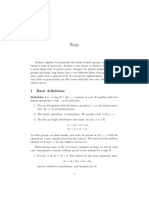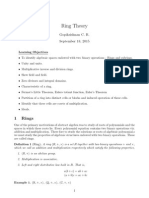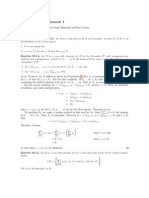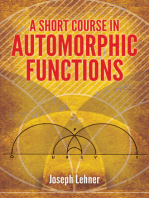Ideals, Homomorphisms and Factor Rings
Ideals, Homomorphisms and Factor Rings
Uploaded by
sarsaranCopyright:
Available Formats
Ideals, Homomorphisms and Factor Rings
Ideals, Homomorphisms and Factor Rings
Uploaded by
sarsaranOriginal Title
Copyright
Available Formats
Share this document
Did you find this document useful?
Is this content inappropriate?
Copyright:
Available Formats
Ideals, Homomorphisms and Factor Rings
Ideals, Homomorphisms and Factor Rings
Uploaded by
sarsaranCopyright:
Available Formats
Chapter 3 Ideals, Homomorphisms and Factor Rings
3.1 Ring Homomorphisms and Ideals
In this section we develop some more of the abstract theory of rings. In particular we will describe those functions between rings that preserve the ring structure, and we will look at another way of forming new rings from existing ones. Denition 3.1.1 Let R be a ring. A non-empty subset S of R is a subring of R if it is itself a ring under the addition and multiplication of R. This means that S is closed under the addition and multiplication of R, that it contains the zero element of R, and that it contains the negative of each of its elements. EXAMPLES 1. Z is a subring of Q. Q is a subring of R. R is a subring of C. 2. The ring Mn (F) of n n matrices over a eld F has the following subrings : Dn (F) - the ring of diagonal n n matrices over F. Un (F) - the ring of upper triangular n n matrices over F. 3. For any eld F, F is a subring of the polynomial ring Mn (F). So also is F[x2 ], the subset of F[x] consisting of those polynomials in which the coefcient of xi is zero whenever i is odd. 4. Every (non-zero) ring R has at least two subrings - the full ring R and the zero subring {0R } 24
QUESTIONS
FOR THE
SEMINAR :
1. Give two more examples of subrings of Mn (Q). 2. Suppose that S is a subring of a ring R. Is it possible that S could have an identity element for multiplication that is different from the identity element of R? Could this happen if R is an integral domain? Denition 3.1.2 Let R and S be rings. A function : R S is a ring homomorphism if for all x, y R we have (x + y) = (x) + (y) and (xy) = (x)(y). EXAMPLES 1. Choose a positive integer n and dene n : Z Z/nZ to be the function that sends k Z to the congruence class modulo n to which k belongs. Then n is a ring homomorphism. 2. Let F be a eld. If a F we can dene a homomorphism a : F[x] F given by a (f(x)) = f(a) for f(x) F[x]. QUESTION FOR THE SEMINAR: Determine whether each of the following is a ring homomorphism : 1. The function det : M2 (Q) Q that associates to every matrix its determinant. 2. The function g : Z Z dened by g(n) = 2n, for n Z. 3. The function : Q[x] Q dened for f(x) Q[x] by (f(x)) = the sum of the coefcients of f(x).
25
Denition 3.1.3 Suppose that : R S is a homomorphism of rings. The kernel of is the subset of R dened by ker = {r R : (r) = 0S }. The image of is the subset of S dened by Im = {s S : s = (r) for some r R}.
Lemma 3.1.4 Im is a subring of S. Proof: First we need to show that Im is closed under the addition and multiplication of S. So suppose that s1 , s2 are elements of Im and let r1 , r2 be elements of R for which s1 = (r1 ) and s2 = (r2 ). Then (r1 + r2 ) = (r1 ) + (r2 ) = s1 + s2 and so s1 + s2 Im. Also (r1 r2 ) = (r1 )(r2 ) = s1 s2 and so s1 s2 Im. Next we show that 0S Im. To see this observe that (0R ) + (0r ) = (0R + 0R ) = (0R ). Subtracting the element (0R ) of S from both sides gives (0R ) = 0S . Thus 0S Im - in fact we have proved something more than this, namely that 0S is the image of 0R . Finally we show that Im contains the additive inverse in S of each of its elements. Let s Im and let r be an element of R for which (r) = s. Then (r) + (r) = (0R ) = 0S . Thus (r) is the additive inverse of s in S, i.e. s = (r) and Im contains the negative of each of its elements.
26
Lemma 3.1.5 ker is a subring of R. Proof: Let r1 , r2 ker . Then (r1 ) = (r2 ) = 0S . We have (r1 + r2 ) = (r1 ) + (r2 ) = 0S + 0S = 0S , and (r1 r2 ) = (r1 )(r2 ) = 0S 0S = 0S . Thus ker is closed under addition and multiplication in R. To see that 0R ker we note that (0R ) = 0S by the proof of Lemma 3.1.4 above. Finally if r ker then 0S = (r + r) = (r) + (r) = (r) + 0S and so (r) = 0 and r ker . Thus ker is a subring of R. In fact ker is not just a subring of R - it has an extra property. Suppose r ker and let x be any element of R. Then xr and rx belong to ker , since (xr) = (x)(r) = (x)0S = 0S , (rx) = (r)(x) = 0S (x) = 0S . So not only is ker closed under its own multiplication, it is also closed under the operation of multiplying an element of ker by any element of R. Denition 3.1.6 Let R be a ring. A left ideal of R is a subring IL of R with the additional property that xa IL whenever a IL and x R. A right ideal of R is a subring IR of R with the additional property that ax IR whenever a IR and x R. A two-sided ideal of R is a subring I of R with the additional property that both xa and ax are in I whenever a I and x R.
QUESTION FOR THE SEMINAR : Find some examples of left, right, or two-sided ideals in each of the following rings : Z, Q, Q[x], Z[x], M2 (Q). NOTES 1. If R is commutative then every left or right ideal of R is a two-sided ideal. We do not talk about two-sided ideals in this case, just ideals. 2. (Two-sided) ideals play a role in ring theory similar to that played by normal subgroups in group theory. 27
EXAMPLES 1. Let R be a ring. We have already seen that the kernel of any ring homomorphism with domain R is a (two-sided) ideal of R. 2. The subrings 2Z = {. . . , 2, 0, 2, 4, . . . } 3Z = {. . . , 3, 0, 3, 6, . . . } are ideals of Z. In general if n Z we will denote by nZ or n the subring of Z consisting of all the integer multiples of n. In each case n is an ideal of Z, since a multiple of n can be multiplied by any integer and the result is always a multiple of n. Note that n is the kernel of the homomorphism n : Z Z/nZ that sends k Z to the class of k modulo n. 3. Fix a polynomial f(x) Q[x]. We denote by f(x) the subring of Q[x] consisting of all those polynomials of the form g(x)f(x) for an element g(x) of Q[x]. Then f(x) is an ideal of Q[x], called the principal ideal generated by f(x). 4. Let R be any ring and let a R. We dene Ra = {ra : r R}. Then Ra is a left ideal of R called the principal left ideal generated by a. Similarly aR = {ar : r R} is the principal right ideal generated by a. If R is commutative then aR = Ra for all a R, and this ideal is called the principal ideal generated by a. It is denoted by a . In Z, nZ is the principal ideal generated by n. In general an ideal in a commutative ring is called principal if it is the principal ideal generated by some element. 5. Every non-zero ring R has at least two ideals, namely the full ring R and the zero ideal {0R }. Lemma 3.1.7 Let R be a ring, and let I be an ideal of R. If I contains a unit u of R, then I = R. Proof: Let u1 denote the inverse of u in R. Then u I implies u1 u = 1R belongs to I. Now let r R. Then r1R = r belongs to I, so R I and R = I. Corollary 3.1.8 If F is a eld, then the only ideals in F are the zero ideal (consisting only of the zero element) and F itself. 28
You might also like
- Summon Night 2 Cheat 2Document4 pagesSummon Night 2 Cheat 2ahmad jajuliNo ratings yet
- RingdefsDocument6 pagesRingdefsnikitamadhesiya5No ratings yet
- Minimal, Primitive, and Irreducible Polynomials: Wayne Edward Aitken June 2021 EditionDocument19 pagesMinimal, Primitive, and Irreducible Polynomials: Wayne Edward Aitken June 2021 EditionEmmanuel SánchezNo ratings yet
- Chapter VIII BenbenDocument11 pagesChapter VIII Benbenapi-319349159No ratings yet
- Honors Algebra 4, MATH 371 Winter 2010: Solutions 2Document5 pagesHonors Algebra 4, MATH 371 Winter 2010: Solutions 2Muhammed AydoğduNo ratings yet
- 03 Integral DomainsDocument9 pages03 Integral DomainsAtarige Moses100% (1)
- On Smarandache Rings IIDocument12 pagesOn Smarandache Rings IIMia AmaliaNo ratings yet
- RingsDocument30 pagesRingsWenyi GuoNo ratings yet
- Burde 37 Comm AlgDocument90 pagesBurde 37 Comm Algalin444444No ratings yet
- Rings: 1 Basic DefinitionsDocument11 pagesRings: 1 Basic DefinitionsAchyuta RanjanNo ratings yet
- Alg3 PDFDocument11 pagesAlg3 PDFmasrawy2010No ratings yet
- Rings With No Maximal IdealsDocument7 pagesRings With No Maximal Idealsjafari2004No ratings yet
- MAS 305 Algebraic Structures II: Notes 12 Autumn 2006Document5 pagesMAS 305 Algebraic Structures II: Notes 12 Autumn 2006Fatima SadikNo ratings yet
- The Jacobson RadicalDocument7 pagesThe Jacobson RadicalAlan CorderoNo ratings yet
- N-Ideals of Rings: International Journal of Algebra, Vol. 6, 2012, No. 25, 1227 - 1232Document6 pagesN-Ideals of Rings: International Journal of Algebra, Vol. 6, 2012, No. 25, 1227 - 1232msmramansrimathiNo ratings yet
- Randal Ect 3Document9 pagesRandal Ect 3alin444444No ratings yet
- 111B Midterm and Final PreparationDocument5 pages111B Midterm and Final PreparationOutworld DevourerNo ratings yet
- Ring Theory Background: 0.1 Prime AvoidanceDocument7 pagesRing Theory Background: 0.1 Prime Avoidancesticker592No ratings yet
- Module Versus Vector Space (Extended Form)Document12 pagesModule Versus Vector Space (Extended Form)pksharma_davc2425No ratings yet
- Abstract Group 6Document16 pagesAbstract Group 6bonifacio gianga jrNo ratings yet
- Ring TheoryDocument5 pagesRing TheorySofia FuentesNo ratings yet
- 1 Continuous Extensions of Submodular Functions: 1.1 Convex and Concave ClosuresDocument5 pages1 Continuous Extensions of Submodular Functions: 1.1 Convex and Concave ClosuresluikovicasNo ratings yet
- Rings and Modules Old Syllabus For O4: T. W. K Orner October 5, 2004Document52 pagesRings and Modules Old Syllabus For O4: T. W. K Orner October 5, 2004Meenu GuptaNo ratings yet
- Paper 1Document5 pagesPaper 1vaishnavi semwalNo ratings yet
- (Mathematica Slovaca) Existence of Derivations On Near-RingsDocument18 pages(Mathematica Slovaca) Existence of Derivations On Near-RingsMuhammad Abdurrahman RoisNo ratings yet
- Characterization of Fuzzy Sub L - RingsDocument6 pagesCharacterization of Fuzzy Sub L - RingsmsmramansrimathiNo ratings yet
- Oxford OCW - Rings and ModulesDocument36 pagesOxford OCW - Rings and Modulessdeftek7972No ratings yet
- Hw-Solns Ring TheoryDocument4 pagesHw-Solns Ring Theoryproject2124No ratings yet
- Rings: Commutative Rings, in General Ideals and Factor Rings Integral DomainsDocument5 pagesRings: Commutative Rings, in General Ideals and Factor Rings Integral Domainsjayant5253No ratings yet
- Alpha Skew Mcoy Rings (PUBLICATIONS DE L'INSTITUT MATHÉMATIQUE 2014)Document8 pagesAlpha Skew Mcoy Rings (PUBLICATIONS DE L'INSTITUT MATHÉMATIQUE 2014)a.nejati1356No ratings yet
- Rings With A Cyclic Group of UnitsDocument9 pagesRings With A Cyclic Group of UnitsBella RahmatullahNo ratings yet
- Anderson 1976Document9 pagesAnderson 1976chhiti.medNo ratings yet
- On Smarandache RingsDocument8 pagesOn Smarandache RingsRyanEliasNo ratings yet
- Solutions For Chapter III. Updated January 20, 2007.: R S N MDocument17 pagesSolutions For Chapter III. Updated January 20, 2007.: R S N Myacp16761No ratings yet
- A Polynomial Ring SamplerDocument8 pagesA Polynomial Ring SamplervictorkrullNo ratings yet
- Module Versus Vector SpaceDocument10 pagesModule Versus Vector SpaceDr. P.K.Sharma100% (2)
- Documento AlgebraDocument8 pagesDocumento AlgebraSebastian David Higuera RinconNo ratings yet
- Eur Math137 ProjectSchemesDocument8 pagesEur Math137 ProjectSchemesChris EurNo ratings yet
- On The Structure of Principal Ideal Rings: Thomas W. HungerfordDocument6 pagesOn The Structure of Principal Ideal Rings: Thomas W. HungerfordsivaNo ratings yet
- Noetherian RingDocument6 pagesNoetherian RingJeano CarlosNo ratings yet
- Commutative RingDocument7 pagesCommutative RingAnurag SinghNo ratings yet
- Liouville's Theorem On Integration in Terms of Elementary FunctionsDocument26 pagesLiouville's Theorem On Integration in Terms of Elementary FunctionsVigen ChaltikyanNo ratings yet
- Tame Topology and O-Minimal StructuresDocument27 pagesTame Topology and O-Minimal StructuresPefwefwevgNo ratings yet
- RingsDocument22 pagesRingsneeshu.ch252No ratings yet
- Factorization 1Document18 pagesFactorization 1ayushhthapa039No ratings yet
- 3201 Chapter1Document7 pages3201 Chapter1JIGAR SAGARNo ratings yet
- The Basic Facts About Rings: DownloadDocument6 pagesThe Basic Facts About Rings: DownloadTom DavisNo ratings yet
- Math 202 - Assignment 1Document14 pagesMath 202 - Assignment 1postalservice216No ratings yet
- Galois Lecture NotesDocument35 pagesGalois Lecture NoteshumejiasNo ratings yet
- Algnotes 11Document4 pagesAlgnotes 11geetofficial777No ratings yet
- Ring Theory PDFDocument8 pagesRing Theory PDFSofia FuentesNo ratings yet
- The Ring R (X)Document15 pagesThe Ring R (X)chhiti.medNo ratings yet
- Section1 3Document2 pagesSection1 3Arun TyagiNo ratings yet
- The Rings R (X) and R (X) : AndersonDocument20 pagesThe Rings R (X) and R (X) : Andersonchhiti.medNo ratings yet
- On Zero-Divisor Graphs of Small Finite Commutative Rings: Shane P. RedmondDocument17 pagesOn Zero-Divisor Graphs of Small Finite Commutative Rings: Shane P. Redmondsaroj gurungNo ratings yet
- Discrete Series of GLn Over a Finite Field. (AM-81), Volume 81From EverandDiscrete Series of GLn Over a Finite Field. (AM-81), Volume 81No ratings yet
- Convolution and Equidistribution: Sato-Tate Theorems for Finite-Field Mellin Transforms (AM-180)From EverandConvolution and Equidistribution: Sato-Tate Theorems for Finite-Field Mellin Transforms (AM-180)No ratings yet
- 061833291X ch04Document110 pages061833291X ch04sarsaranNo ratings yet
- Bateman H Partial Differential Equations of Mathematical PhysicsDocument556 pagesBateman H Partial Differential Equations of Mathematical PhysicssarsaranNo ratings yet
- Bateman H Partial Differential Equations of Mathematical PhysicsDocument556 pagesBateman H Partial Differential Equations of Mathematical PhysicssarsaranNo ratings yet
- Troutmal CalculusOpControlDocument479 pagesTroutmal CalculusOpControlVuhuu NhuNo ratings yet
- Problem Set 3: The Due Date For This Homework Is Sun 3 Feb 2013 11:59 PM PSTDocument3 pagesProblem Set 3: The Due Date For This Homework Is Sun 3 Feb 2013 11:59 PM PSTsarsaranNo ratings yet
- Linear Fredholm Integral Equations and The Integral of KurzweilDocument28 pagesLinear Fredholm Integral Equations and The Integral of KurzweilsarsaranNo ratings yet
- HRTHRTDocument32 pagesHRTHRTsarsaranNo ratings yet
- ODE2Document7 pagesODE2sarsaranNo ratings yet
- Section3 3Document5 pagesSection3 3sarsaranNo ratings yet
- Motivation Concepts To ApplicationDocument8 pagesMotivation Concepts To ApplicationJITESHNo ratings yet
- Homeroom GuidanceDocument5 pagesHomeroom GuidanceKim UnalanNo ratings yet
- Keyboard TechniqueDocument5 pagesKeyboard TechniqueJOHNREY BASIDNo ratings yet
- United States Court of Appeals, Ninth CircuitDocument8 pagesUnited States Court of Appeals, Ninth CircuitScribd Government DocsNo ratings yet
- Study Guide For MGR Exam 2 PDFDocument10 pagesStudy Guide For MGR Exam 2 PDFRandyNo ratings yet
- Egain11 4 Results First AnalyticsDocument35 pagesEgain11 4 Results First AnalyticsErnestNo ratings yet
- Application Form With Passport Size PhotoDocument1 pageApplication Form With Passport Size PhotoFrank GabiaNo ratings yet
- CV300 2Document13 pagesCV300 2Achariya ParpromNo ratings yet
- Account StatementDocument12 pagesAccount StatementSMILLING CLOUDNo ratings yet
- Leadership, Complexity & Change Recap Change and Leadership: Bristol MBADocument57 pagesLeadership, Complexity & Change Recap Change and Leadership: Bristol MBAMohammad Sabbir Hossen SamimNo ratings yet
- Non Compliance ApplicationDocument10 pagesNon Compliance ApplicationRAJARAJESHWARI M GNo ratings yet
- Adoraciones Matutinas OrdenadasDocument12 pagesAdoraciones Matutinas OrdenadasCamila SanchezNo ratings yet
- Management - CoordinationDocument20 pagesManagement - CoordinationAshlyn Jane LoboNo ratings yet
- Resolva As Tag Questions Abaixo Como Estudamos em Sala. Exemplo: It's Very ColdDocument4 pagesResolva As Tag Questions Abaixo Como Estudamos em Sala. Exemplo: It's Very ColdY 1 K 3 SNo ratings yet
- CV Nikola MitrovicDocument2 pagesCV Nikola MitrovicnidzomirNo ratings yet
- Nasi ISpani Booklet (16 June 2023)Document92 pagesNasi ISpani Booklet (16 June 2023)Belinda EloffNo ratings yet
- High Speed Solvent PrinterDocument2 pagesHigh Speed Solvent PrinterhsooomhsooomeNo ratings yet
- Poweredge t610 Technical GuidebookDocument58 pagesPoweredge t610 Technical GuidebookPeter AmmenNo ratings yet
- Unit 6 Learning Aim E Assessment MatDocument2 pagesUnit 6 Learning Aim E Assessment Mathello'iNo ratings yet
- Key Concept of ESBDocument10 pagesKey Concept of ESBPramod DeshmukhNo ratings yet
- Sat BooksDocument1 pageSat BooksFiras SadaNo ratings yet
- AccreditationDocument35 pagesAccreditationSatish PatilNo ratings yet
- English 9Document5 pagesEnglish 9SHERYL100% (1)
- A Presentation On Shoping HabitDocument35 pagesA Presentation On Shoping HabitNilofar MamoonNo ratings yet
- Article of FaithDocument9 pagesArticle of FaithStoryKing100% (2)
- Eca Ebola Report Final Eng PDFDocument86 pagesEca Ebola Report Final Eng PDFTina chackoNo ratings yet
- 02769K HT F450BK Eng - Mic 0218 PDFDocument30 pages02769K HT F450BK Eng - Mic 0218 PDFbintangaditya19No ratings yet
- 9akk106354a3359 Emergi-Lite Uk 2020 CT DGTDocument152 pages9akk106354a3359 Emergi-Lite Uk 2020 CT DGTOjog Ciprian AlinNo ratings yet
- How To Find Your Life Purpose Personal Excellence EbookDocument69 pagesHow To Find Your Life Purpose Personal Excellence EbookAnkit AgrawalNo ratings yet

































































































